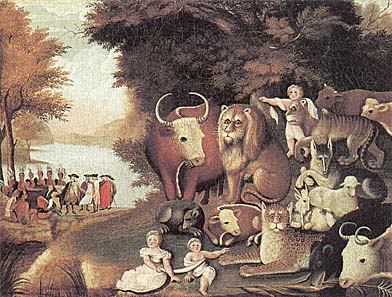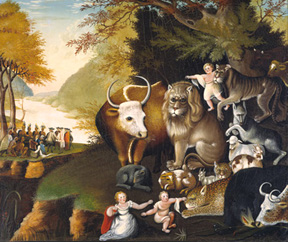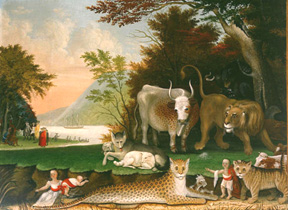|
The Rev. Frank
Logue A
Peaceable Kingdom Within VH1 has a show One Hit Wonders that gives an update on the singers and bands with the one big song that gets a lot of play on the radio, before they drift back to oblivion. I remember Carol Burnett’s sidekick Vicki Lawrence talking about her number one single in 1973, “The Night the Lights Went Out in Georgia.” She told VH1 viewers that a friend warned her to enjoy the fame from the hit, because it wouldn’t last. The friend was right. It turns out, if you only have one trick, it needs to be a good one, something with staying power. Edward Hicks (1780-1849) is the one-hit wonder of the 19th century art world. His painting Peaceable Kingdom is very widely known. Though it would be more correct to say, Peaceable Kingdom paintings as the self-taught artist painted the same scene a number of different ways in his approximately 100 renditions of it. Hicks began painting as a sign maker who also decorated carriages with scenes such as Washington crossing the Delaware. It was a controversial choice of occupations as Edward Hicks was a Quaker, the group more properly known as the Society of Friends. Quakers were against most artistic renderings as being idolatrous. But, Hicks could not make a go as a farmer, and he did have a talent for painting and he appeased his fellow Quakers by refusing to paint portraits.
Edward Hicks was also a preacher who taught about symbolism in art which gives insight into the painter’s best-known work. He had learned of the ancient practice of using animals in art as a symbol of some aspect of human personality. One website[1] notes some of Hicks symbols as, “The lion was quick-tempered and willful. The wolf was full of melancholy and reserved. The bear was sluggish and greedy. The leopard, buoyant…the little child had appeared in earlier paintings representing liberty and freedom from autocratic oppression. Politically, that meant kings and princes for' Hicks. But spiritual freedom also has to be obtained. There is a struggle against a foe, not British Quakers or material riches, but the weakness and characteristics of a willful self.” In Hicks’ Peaceable Kingdom there is a tension that goes beyond the animal kingdom, for the symbolism he preached on connects the animals in his paintings to the human personality. There is a balance among the human tendencies when the quick-tempered is balanced by the sluggish. The Quakers had come to America seeking a peaceable kingdom on earth where they could worship. Led by William Penn, who was known for the Holy Experiment in which he made and kept a treaty with the Leni Lenape people, who he had written from England saying, “I desire to gain your Love and Friendship by a kind, Just and Peaceable Life.”
Hicks own religious beliefs came to differ from the mainstream of the Quaker movement. Hicks was influenced more by quietist movement of the 1700s, which taught an annihilation of the will in abandoning yourself to God while stressing the importance of the Quaker ideal of being connected with the Inner Light. Edward Hicks, the painter who was also preached became a spokesman, through his paintings and preaching, for those who became known as the Hicksites. The group was not named for him, but for a second cousin, Elias Hicks. For the Hicksites, their fellow Quakers were leaning toward seeing themselves as the spiritual elite, while also becoming more worldly. The Hicksites came to see Quaker leaders as just men, rather than leaders who followed of the Inner Light which came from Christ. The other Quakers saw the Hicksites as following the Inner Light so strongly that they did not properly value scripture or the historic Christ.
Always to the left and in the background Hicks added William Penn making the treaty with the Leni Lenape people. Sometimes there was an arriving ship. This was the original peaceable kingdom, William Penn charting the course for “a kind, Just and Peaceable Life.” The sign painter Hicks was getting more obvious with his symbols. He added more noted Quakers in the left, some with banners over their shoulders like a beauty pageant winner, but the banners gave slogans such as “Mind the Inner Light.” He sometimes added a tree split by lightning. Clearly for Hicks, the ideal of the peaceable kingdom on earth was slipping away. His paintings became more accomplished even as they more desperately tried to convey the teaching. If we could just look across the ravine to see how the early Quakers had done it, we could still get that eternal balance right and create the peaceable kingdom on earth. The animals began to look grayer in the muzzle, but Hicks kept finding the inner light in the lion and the bear, a miracle was still possible. The ideal started to slip away. Yet, Hicks kept painting. He blamed the same human tendencies toward egoism and greed that he had painted for years. The people just needed to tame the beasts within for there to be peace without. The peaceable kingdom could become a reality. The inner light would not, could not fail. It was the people who were falling short. And here I stop with the story of Edward Hicks. He never did stop believing in the power of the Inner Life of Christ to transform a person. He never stopped hoping and praying for the peaceable kingdom on earth. Isaiah’s image “The wolf shall live with the lamb, the leopard shall lie down with the kid, the calf and the lion and the fatling together, and a little child shall lead them” has fixed itself in human consciousness. Isaiah held out the vision of the peace that was possible with an ideal leader. The passage begins by declaring, “A shoot will come up from the stump of Jesse; from his roots a branch will bear much fruit.” Jesse was the father of Israel’s great King David and so the grandfather of Solomon. Israel’s greatness came from Jesse’ offspring and this passage calls for that same stock, the same root to produce another great leader. We know that this was first seen in Israel as the promise of another great king who would descend from David. In time that vision of a peaceable kingdom on earth also faded and the people came to see that this passage was messianic, pointing to the ideal leader, the Messiah. So perhaps the anguish of Hicks had been prefigured in Israel. Hicks hoped for a peaceable kingdom in the here and now, but it was not to be. The ultimate place of peace and justice is yet to come. Just as Hicks found this out in the 1800s, so Israel had discovered this before Jesus’ birth. We read this passage in Advent as it points toward the coming of Jesus, the Messiah and then beyond his first Advent in Bethlehem to his Second Coming to bring about the real peaceable kingdom, the Kingdom of Heaven. Jesus first coming was as a little child to lead us, the one to show us the possibility of peace and justice, by demonstrating what the Kingdom of God looks like on earth. But the powers of this world would not tolerate a perfect earthly kingdom then any better than now. The same problems of ego and greed that Hicks identified drift to the surface, and why not for they rise up in each of us. Hicks was right, the battle was not without, but within. The peaceable kingdom may not be possible on earth, but it is possible to fight the battle within us as our own inner lion and wolf seek to lie down with the lamb. The answer now as with Hicks and with Isaiah is the child. The child we now know with hindsight to be the Christ child born in a stable in Bethlehem.
Hicks one hit was to be a painting that showed us how to have peace on earth, instead he showed us the importance of the child of wonder whose birth we will soon celebrate. The purpose of this season of Advent is to make room in our hearts to receive the Christ child anew. He is the one who will in Isaiah’s words, “not judge by what he sees with his eyes, or decide by what he hears with his ears…” for he will look to your heart. Pray that God will make your own heart a peaceable kingdom this Advent as you make room in it for the little child to lead you once again. Amen. |

 Hick’s One Hit Wonder of the
Peaceable Kingdom was taken from our Old Testament lesson from Isaiah, “The
wolf shall live with the lamb, the leopard shall lie down with the kid, the
calf and the lion and the fatling together, and a little child shall lead
them.” Hicks portrays this scene with the animals showing a bit of pop-eyed
amazement at finding themselves so close to their one-time enemies.
Hick’s One Hit Wonder of the
Peaceable Kingdom was taken from our Old Testament lesson from Isaiah, “The
wolf shall live with the lamb, the leopard shall lie down with the kid, the
calf and the lion and the fatling together, and a little child shall lead
them.” Hicks portrays this scene with the animals showing a bit of pop-eyed
amazement at finding themselves so close to their one-time enemies. It was Penn’s sort of
peaceable kingdom on earth that Edward Hicks painted. All the animals are
together. The varying predispositions of humans for good and evil are in
balance and the child, who is liberty and freedom, leads. For Hicks, this was
not a utopia of human design, but a God-given heaven on earth as people lived
according to the Quaker ideals. The Society of Friends could create a
peaceable kingdom in the here and now, foreshadowing the Kingdom of God.
It was Penn’s sort of
peaceable kingdom on earth that Edward Hicks painted. All the animals are
together. The varying predispositions of humans for good and evil are in
balance and the child, who is liberty and freedom, leads. For Hicks, this was
not a utopia of human design, but a God-given heaven on earth as people lived
according to the Quaker ideals. The Society of Friends could create a
peaceable kingdom in the here and now, foreshadowing the Kingdom of God.
 As Hicks progressed in both
his skills as a painter and his convictions that the bulk of his fellow
Quakers had gone astray, the Peaceable Kingdom painting changed. Hicks added a
divide which grew from a ditch to a chasm as the painting progressed. The one
child became children, sometimes playing dangerously on the edge of the
precipice.
As Hicks progressed in both
his skills as a painter and his convictions that the bulk of his fellow
Quakers had gone astray, the Peaceable Kingdom painting changed. Hicks added a
divide which grew from a ditch to a chasm as the painting progressed. The one
child became children, sometimes playing dangerously on the edge of the
precipice. For Hicks, the Inner Light
was that light of that Christ child infusing your whole being so that your
inner lion and wolf bear the image of Christ as much as the lamb within. For
as much as Hicks wanted his paintings to show the way forward for a better
life in Pennsylvania in the early 1800s, all they could really show was the
work we all have to do on the inside as we come to terms with our own ego, our
own greed and the challenges of letting that Christ child lead.
For Hicks, the Inner Light
was that light of that Christ child infusing your whole being so that your
inner lion and wolf bear the image of Christ as much as the lamb within. For
as much as Hicks wanted his paintings to show the way forward for a better
life in Pennsylvania in the early 1800s, all they could really show was the
work we all have to do on the inside as we come to terms with our own ego, our
own greed and the challenges of letting that Christ child lead.